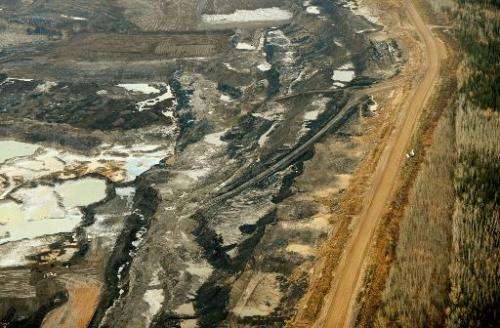Canada approves pipeline to Pacific Ocean, with conditions

Canada approved construction Tuesday of a pipeline to the Pacific Ocean, opening up one of the world's largest oil fields as Washington dithers over another link southward from Alberta's oil sands.
The Northern Gateway project gained momentum after US President Barack Obama delayed a decision on another pipeline—Keystone XL—first proposed in 2008 to move Alberta bitumen to refineries along the US Gulf Coast.
The oil conduit from landlocked Alberta to the sea would propel further development of the province's oil sands, unleashing tremendous economic kickbacks for Canadians, Natural Resources Minister Greg Rickford has said.
In a statement Tuesday, the minister said the government accepted an independent review panel's recommendation to approve the project, with 209 conditions to mitigate environmental impacts.
"Moving forward, the proponent (Enbridge) must demonstrate... how it will meet the 209 conditions," Rickford added.
The government's nod is the last major administrative hurdle for the Can$7.9 billion (US$7.3 billion) Northern Gateway project.
The pipeline project itself is the first to be approved to enable Canada to diversify markets for its crude oil.
However, opponents refused to lie down, vowing civil disobedience and court challenges to try to stop it, while opposition New Democratic Party leader Tom Mulcair vowed to kill the project if his party wins elections scheduled for 2015.
Approval is politically risky for Prime Minister Stephen Harper's ruling Conservatives, with 21 Tory MPs seeking re-election in westernmost British Columbia, where most voters oppose the pipeline.
Mulcair accused the government of gutting environmental legislation and trampling aboriginal treaty rights to push through regulatory approvals for the pipeline.
"This fight is far from over," he said.
"This project will be challenged in the courts and on the ground," said activist group Environmental Defense.
"It will never be built," vowed Greenpeace.
Endbridge meanwhile said it would engage aboriginal communities, the province of British Columbia and others "to build further trust and seek additional input that would make the project even better."
Enbridge's Northern Gateway project aims to move 525,000 barrels of crude per day from Edmonton, Alberta across 1,178 kilometers (732 miles) of rugged mountain landscapes to a new marine terminal in Kitimat on British Columbia's northern coast, for shipping to Asia..
Environmentalists and aboriginals fear a spill could damage the pristine coastline that includes salmon-bearing rivers and the habitat of a rare white bear.
The National Energy Board in December acknowledged that a major spill could be disastrous but determined that redundant safety systems proposed by Enbridge would significantly mitigate the risk of malfunctions or accidents.
Canada holds the third-largest oil reserves in the world.
Virtually all of its energy exports go to the United States, but after Washington initially balked at TransCanada's proposed Keystone XL pipeline, focus shifted to China and other Pacific nations as new customers.
© 2014 AFP



















